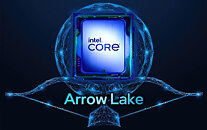- Joined
- Aug 19, 2017
- Messages
- 2,590 (0.97/day)
A leaked Intel documentation we reported on a few days ago covered the Arrow Lake-S platform and some implementation details. However, there was an interesting catch in the file. The leaked document indicates that the upcoming 15th-Generation Arrow Lake desktop CPUs could lack Hyper-Threading (HT) support. The technical memo lists Arrow Lake's expected eight performance cores without any threads enabled via SMT. This aligns with previous rumors of Hyper-Threading removal. Losing Hyper-Threading could significantly impact Arrow Lake's multi-threaded application performance versus its Raptor Lake predecessors. Estimates suggest HT provides a 10-15% speedup across heavily-threaded workloads by enabling logical cores. However, for gaming, disabling HT has negligible impact and can even boost FPS in some titles. So Arrow Lake may still hit Intel's rumored 30% gaming performance targets through architectural improvements alone.
However, a replacement for the traditional HT is likely to come in the form of Rentable Units. This new approach is a response to the adoption of a hybrid core architecture, which has seen an increase in applications leveraging low-power E-cores for enhanced performance and efficiency. Rentable Units are a more efficient pseudo-multi-threaded solution that splits the first thread of incoming instructions into two partitions, assigning them to different cores based on complexity. Rentable Units will use timers and counters to measure P/E core utilization and send parts of the thread to each core for processing. This inherently requires larger cache sizes, where Arrow Lake is rumored to have 3 MB of L2 cache per core. Arrow Lake is also noted to support faster DDR5-6400 memory. But between higher clocks, more E-cores, and various core architecture updates, raw throughput metrics may not change much without Hyper-Threading.


View at TechPowerUp Main Site | Source
However, a replacement for the traditional HT is likely to come in the form of Rentable Units. This new approach is a response to the adoption of a hybrid core architecture, which has seen an increase in applications leveraging low-power E-cores for enhanced performance and efficiency. Rentable Units are a more efficient pseudo-multi-threaded solution that splits the first thread of incoming instructions into two partitions, assigning them to different cores based on complexity. Rentable Units will use timers and counters to measure P/E core utilization and send parts of the thread to each core for processing. This inherently requires larger cache sizes, where Arrow Lake is rumored to have 3 MB of L2 cache per core. Arrow Lake is also noted to support faster DDR5-6400 memory. But between higher clocks, more E-cores, and various core architecture updates, raw throughput metrics may not change much without Hyper-Threading.


View at TechPowerUp Main Site | Source





